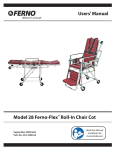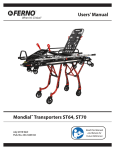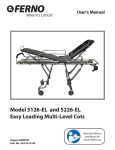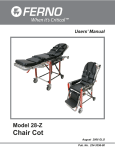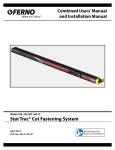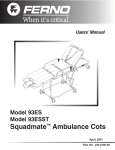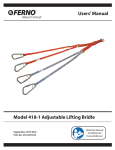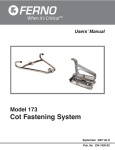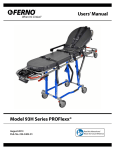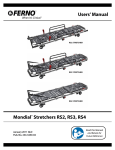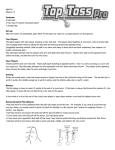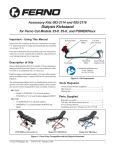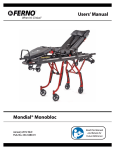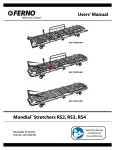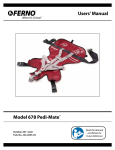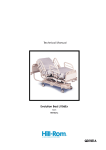Download USing the Cot
Transcript
FERNO ® When It’s Critical Users’ Manual ® Model 26-S Cot Model 26 Cot Model 26-AS Cot Model 26 Series Cot March 2010 GLO Pub. No. 234-2041-04 Read this Manual and Retain for Future Reference Model 26 Series Cot Ferno Customer Relations For ordering assistance or general information: Canada and the U.S.A. Telephone (Toll-free) Telephone Fax (Toll-free) Fax 1.877.733.0911 1.937.382.1451 1.888.388.1349 1.937.382.1191 Internet www.ferno.com All Other Locations For assistance or information, please contact your Ferno distributor. If you do not have a Ferno distributor, please contact Ferno Customer Relations: Ferno-Washington, Inc. 70 Weil Way Telephone Fax Wilmington, Ohio 45177-9371, U.S.A. +1.937.382.1451 +1.937.382.6569 Internet www.ferno.com European Representative Ferno (UK) Limited Stubs Beck Lane, Cleckheaton West Yorkshire BD19 4TZ, United Kingdom Telephone +44 (0) 1274 851999 Fax +44 (0) 1274 851111 Internet www.ferno.co.uk Ferno Technical Support Customer service and product support are important aspects of each Ferno product. Please have the product serial number available when calling, and include it in all written communications. For technical support questions: Telephone (Toll-free) 1.800.733.3766 ext. 1010 Telephone 1.937.382.1451 ext. 1010 Email [email protected] users’ manual To request additional free users’ manuals, contact Ferno Customer Relations, your Ferno distributor, or visit www.ferno.com. Serial Number _________________________ Location: Foot-End Crosstube Disclaimer This manual contains general instructions for the use, operation and care of this product. The instructions are not all-inclusive. Safe and proper use of this product is solely at the discretion of the user. Safety information is included as a service to the user. All other safety measures taken by the user should be within and under consideration of applicable regulations. It is recommended that training on the proper use of this product be provided before using this product in an actual situation. Retain this manual for future reference. Include it with the product in the event of transfer to new users. Additional free copies are available upon request from Customer Relations. Proprietary Notice The information disclosed in this manual is the property of FernoWashington, Inc., Wilmington, Ohio, USA. Ferno-Washington, Inc. reserves all patent rights, proprietary design rights, manufacturing rights, reproduction use rights, and sales use rights thereto, and to any article disclosed therein except to the extent those rights are expressly granted to others or where not applicable to vendor proprietary parts. Limited Warranty Statement The products sold by Ferno are covered by a limited warranty, which is printed on all Ferno invoices. The complete terms and conditions of the limited warranty, and the limitations of liability and disclaimers, are also available upon request by calling Ferno at 1.800.733.3766 or 1.937.382.1451. © Copyright Ferno-Washington, Inc. All Rights Reserved. 2 © Ferno-Washington, Inc 234-2041-04 March 2010 Model 26 Series Cot Table of Contents Section Page Ferno Customer Relations_______________________ 2 Ferno Technical Support________________________ 2 1 - Safety Information____________________________ 4 1.1 Warning_________________________________ 4 1.2 Important________________________________ 4 1.3 Bloodborne Disease Notice__________________ 4 1.4 Cot and Fastener Compatibility_ _____________ 4 1.5 Symbol Glossary__________________________ 4 1.6 Safety and Instruction Labels________________ 5 2 - Operator Skills and Training___________________ 5 2.1 Skills___________________________________ 5 2.2 Training_________________________________ 5 2.3 Height and Strength Considerations___________ 5 3 - About the Cot________________________________ 6 3.1 Cot Description___________________________ 6 3.2 General Specifications and Components_ ______ 7 4 - Using the Features____________________________ 9 4.1 Undercarriage Leg Lock (All Models)_________ 9 4.2 Leg Control Handles (All Models)____________ 9 4.3 Swing-Down Sidearms (All Models)_________ 10 4.4 Auxiliary Lock (All Models)_ ______________ 10 4.5 Adjustable Backrest (All Models)_ __________ 11 4.6 Drop Frame (All Models)__________________ 11 4.7 Shock Frame (Models 26-S and 26-AS Only)__ 12 4.8 Wheel Locks (Optional)___________________ 12 © Ferno-Washington, Inc 234-2041-04 March 2010 Section Page 5 - Using the Cot_______________________________ 13 5.1 Before Placing the Cot in Service____________ 13 5.2 General Guidelines for Use_________________ 13 5.3 Patient Restraints_ _______________________ 13 5.4 Changing Cot Positions___________________ 14 5.5 Rolling the Cot__________________________ 15 5.6 Transferring a Patient to the Cot_____________ 15 5.7 Loading the Cot__________________________ 16 5.8 Unloading the Cot________________________ 16 5.9 Using Additional Help_ ___________________ 17 6 - Maintenance________________________________ 18 6.1 Maintenance Schedule_ ___________________ 18 6.2 Disinfecting and Cleaning the Restraints______ 18 6.3 Disinfecting and Cleaning the Mattress_______ 18 6.4 Disinfecting the Cot_ _____________________ 18 6.5 Cleaning the Cot_________________________ 18 6.6 Waxing the Cot__________________________ 19 6.7 Inspecting the Cot________________________ 19 6.8 Lubricating the Cot_______________________ 20 7 - Accessories and Related Products_ _____________ 22 8 - Parts and Service____________________________ 22 8.1 U.S.A. and Canada_______________________ 22 8.2 Worldwide______________________________ 22 8.3 Parts List_______________________________ 22 8.4 Parts Diagrams_ _________________________ 23 Training Record_ ______________________________ 24 Maintenance Record____________________________ 24 3 Safety Information Model 26 Series Cot 1 - Safety Information 1.1 Warning 1.4 Cot and Fastener Compatibility Warning notices indicate a potentially hazardous situation which, if not avoided, could result in injury or death. Combining different manufacturers’ products into a “mixedcomponent” cot/cot fastener system can increase the user’s risk of injury and damage. Warning Untrained operators can cause injury or be injured. Permit only trained personnel to operate the cot. Improper use of the cot can cause injury. Use the cot only for the purpose described in this manual. Improper operation can cause injury. Operate the cot only as described in this manual. An unattended patient can be injured. Stay with the patient at all times. An unrestrained patient can fall off the cot and be injured. Use restraints to secure the patient on the cot. Helpers can cause injury. Maintain control of the cot, operate the controls, and direct all helpers. Helpers can be injured. Show helpers where to grasp the cot to avoid pinch points. Improper maintenance can cause injury. Maintain the cot only as described in this manual. Ferno-Washington, Inc. strongly recommends that only Ferno-manufactured cots be used in Ferno-manufactured cot fasteners, and that only Ferno-manufactured cot fasteners be used for securing Ferno-manufactured cots in ambulances. ANY COMBINATION OF A FERNO COT OR COT FASTENER WITH A NON-FERNO COT OR COT FASTENER IS MISUSE OF THE FERNO PRODUCT. Responsibility for the outcome of known, intentional misuse rests squarely on the misuser. 1.5 Symbol Glossary The symbols defined below are used on the cot and in this users’ manual. Ferno uses symbols recognized by the International Standards Organization (ISO), American National Standards Institute (ANSI) and the emergency medical services industry. Attaching improper items to the cot can cause injury. Use only Ferno-approved items on the cot. 181 kg 400 lb Improper parts and service can cause injury. Use only Ferno parts and Ferno-approved service on the cot. Modifying the cot can cause injury and damage. Use the cot only as designed by Ferno. General Warning of Potential Injury 2 1.2Important Important notices emphasize important usage or maintenance information. Important 1.3Bloodborne Disease Notice To reduce the risk of exposure to bloodborne diseases such as HIV-1 and hepatitis when using the cot, follow the disinfecting and cleaning instructions in this manual. Read the Users’ Manual Unlocked Do Not Lubricate 4 Load Limit Locked Lubricate Cot Operation Requires Two Trained Operators Pinch Point Product Meets European Union Standards © Ferno-Washington, Inc 234-2041-04 March 2010 Operator Skills and Training Model 26 Series Cot 1.6 Safety and Instruction Labels Safety and instruction labels place important information from the users’ manual on the cot. Read and follow label instructions. Replace worn or damaged labels immediately. New labels are available from EMSAR (page 22) or from your distributor. Pinch Point Label Location: cot main frame General Information Label Location: foot end of cot Leg Lock Label Location: Leg Lock Control Bar Auxiliary Lock Information Label Location: auxiliary lock 2 - Operator Skills and Training 2.1 Skills 2.2Training Operators using the cot need: Operator trainees need to: ● a working knowledge of emergency patient-handling procedures. ● the ability to assist the patient. ● read and understand this manual. ● be trained on the use of the cot. ● practice with the cot before using it with a patient. ● record their training information. A sample training record sheet is provided on page 24. Warning Untrained operators can cause injury or be injured. Permit only trained personnel to operate the cot. 2.3Height and Strength Considerations When unloading the cot, the foot-end operator must lift and hold the weight of the cot, patient and equipment high enough for the wheels to remain off the ground until the undercarriage legs completely unfold and lock into place. Be aware that if the ambulance is parked on an uneven surface, the foot-end operator (and any helpers) may need to lift the cot higher than normal to allow the legs to unfold completely and lock. Supporting this weight requires greater strength from short operators than from tall operators because short operators must raise their arms higher in relation to their shoulders. Note: Use additional help as needed to lift the weight of the cot, patient and equipment (see Using Additional Help, page 17). © Ferno-Washington, Inc 234-2041-04 March 2010 5 About the Cot Model 26 Series Cot 3 - About the Cot 3.1 Cot Description The Model 26 Series Cot is an emergency patient-handling device designed to transport a patient in a ground-based ambulance. The cot is for professional use by a minimum of two trained operators. It is designed for roll-in loading to help reduce the risk of back injury to medical service personnel. The cot is designed for use with an approved Ferno® cot fastener (not included). A mattress and set of patient restraints (not included) are required. See Accessories and Related Products, page 22, to order these items. The cots in the Model 26 series are listed below, along with their features. The term “cot” is used in this manual where features are identical among all models. Where features are not shared by all cots, the specific model number is used. compatible Cot fasteners The cot is designed for use with the Ferno® cot fasteners listed here (not included). ● All Models: Ferno® Model 175 Antler-and-Rail Fastener ● Model 26-AS: Ferno® Models 170 and Model 175 Fasteners ● ● ● ● ● ● ● ● Warning Improper use of the cot can cause injury. Use the cot only for the purpose described in this manual. Load Limit 181 kg 400 lb 6 Inspect the cot if the load limit has been exceeded (See Inspecting the Cot, page 19). Cot features (All models) 2 height positions Adjustable backrest Swing-down sidearms Lead handle 5" swivel wheels (foot end); 5" fixed wheels (head end) Undercarriage leg lock Drop frame Foot-end loading posts model-specific features ● Wheel locks on foot-end swivel casters ○○ Model 26 With Wheel Locks ○○ Model 26-AS ○○ Model 26-S ● Trendelenburg position (“shock frame”) ○○ Model 26-AS ○○ Model 26-S ● Anodized main-frame tubing (will not leave black residue on hands) ○○ Model 26-AS ○○ Model 26-S © Ferno-Washington, Inc 234-2041-04 March 2010 About the Cot Model 26 Series Cot 3.2General Specifications and Components AMBULANCE requirements specifications information The patient compartment should have a level floor large enough for the folded cot, and a Ferno cot fastener installed. General specifications are rounded to the nearest whole number. Metric conversions are calculated before rounding the Imperial measurements. For more information, contact Ferno Customer Relations (page 2) or your Ferno distributor. Ferno reserves the right to change specifications without notice. U.S.A. Notice The cot is for use with ambulances that meet the requirements of the “Star of Life” certification via Federal Ambulance Specification KKK-A-1822. For information, contact: Federal Supply Services, Specifications Section Suite 8100 470 E. L’Enfant Plaza, SW Washington, DC 20407 Height is measured as the distance from the ground to the top of the T-casting at the center of the bed frame. Loading height is the distance from the ground to the bottom of the loading wheel. Cot weights are without mattress, restraints and optional features. Model 26 Cot Specifications Height Maximum Loading Minimum Folded Length Overall Width Weight Load Limit 81 cm (32 in.) 60 cm (24 in.) 22 cm (9 in.) 195 cm (77 in.) 58 cm (23 in.) 25 kg (56 lb) 181 kg (400 lb) Adjustable Backrest Swing-Down Sidearms (2) Backrest Control Handle Lead Handle Loading Wheels (2) Undercarriage Leg Lock Undercarriage Drop Frame Control Handles (2) © Ferno-Washington, Inc 234-2041-04 March 2010 Loading Post (2) Swivel Transport Wheels (2) 7 About the Cot Model 26 Series Cot 26-S Cot Specifications Height Maximum Loading Minimum Folded Length Overall Width Weight Load Limit 81 cm 60 cm 22 cm 195 cm 58 cm 25 kg 181 kg (32 in.) (24 in.) (9 in.) (77 in.) (23 in.) (56 lb) (400 lb) Adjustable Backrest Swing-Down Sidearms (2) Backrest Control Handle Shock Frame Lead Handle Loading Wheels (2) Undercarriage Leg Lock Drop Frame Control Handles (2) Undercarriage Swivel Transport Wheels (2) Loading Post (2) 26-AS Cot Specifications Height Maximum Loading Minimum Folded Length Overall Width Weight Load Limit 81 cm 60 cm 22 cm 195 cm 57 cm 28 kg 181 kg Lead Handle (32 in.) (24 in.) (9 in.) (77 in.) (23 in.) (61 lb) (400 lb) 8 Swing-Down Sidearms (2) Backrest Control Handle Shock Frame Loading Wheels (2) Undercarriage Leg Lock Undercarriage Adjustable Backrest Drop Frame Control Handle Foot-End Loading Wheels (2) Swivel Transport Wheels (2) © Ferno-Washington, Inc 234-2041-04 March 2010 Using the Features Model 26 Series Cot 4 - Using the Features 4.1 Undercarriage Leg Lock (All Models) The undercarriage leg lock secures the legs in the folded position. This allows the operators (and helpers) to lift and carry the cot like a stretcher. To engage the leg lock: Important Leg locks on cots before Serial Number L-666059 operate in the opposite direction. Learn about your cot and understand how the leg lock works. 1. Place the cot in the folded position. 2. Pull the lock handle (Figure 1). To disengage the leg lock, push the handle toward the head end of the cot. Note: Do not engage the leg lock while the cot is loaded in an ambulance. Verify that the leg lock is disengaged before unloading the cot from the ambulance. Note: Leg locks on cots with serial numbers before L-666059 operate in the opposite direction: Pushing the handle engages the lock, and pulling the handle disengages the lock. Test the leg lock and learn how it works. Leg Lock Control Handle Figure 1 - Using the Undercarriage Leg Lock 4.2Leg Control Handles (All Models) Two leg control handles are located at the foot end of the cot. They operate the leg locking mechanisms that enable the legs to be folded. The handle on the foot-end operator’s right side unlocks the head-end legs (Figure 2). The handle on the foot-end operator’s left unlocks the foot-end legs. When changing cot positions, both operators grasp the cot with an underhand grip. The foot-end operator operates both leg control handles at once. See Changing Cot Positions, page 14. Figure 2 Using the Control Handles When loading the cot into an ambulance, the foot-end operator operates one leg control handle at a time. See Loading the Cot, page 16. © Ferno-Washington, Inc 234-2041-04 March 2010 9 Using the Features Model 26 Series Cot 4.3 Swing-Down Sidearms (All Models) The swing-down sidearms provide patient security and comfort. Keep the sidearms raised except when transferring a patient to and from the cot. To lower a sidearm, pull the sidearm lock pin and swing the sidearm down (Figure 3). To raise a sidearm, swing the sidearm up until it locks. Optional sidearm release levers allow you to lower a sidearm with one hand (see Parts and Service, page 22). Important Lock Pin Figure 3 Using the Swing-Down Sidearms Do not use the sidearms to lift the cot. Sidearms are not designed for lifting. Lift the cot only by grasping the cot main frame. 4.4 Auxiliary Lock (All Models) The auxiliary lock control handle is located near the foot end of the cot on the patient’s left side. The engaged auxiliary lock prevents the undercarriage from folding. The auxiliary lock engages automatically when the cot is changed from the folded to the raised position. Keep the auxiliary lock engaged except when two operators fold the cot, or when loading the cot into an ambulance. Figure 4 Unlocking the Auxiliary Lock To disengage the auxiliary lock, pull the handle toward the foot end of the cot. As you pull the handle back, also pull down slightly (Figure 4). 10 © Ferno-Washington, Inc 234-2041-04 March 2010 Using the Features Model 26 Series Cot 4.5 Adjustable Backrest (All Models) The backrest adjusts to any of 10 positions. To adjust: 1. Unfasten or loosen the harness restraint. Squeeze to Unlock 2. Support the backrest frame as you squeeze the backrest control handle. 3. Raise or lower the backrest to near the desired position (Figure 5). 4. Release the backrest control handle, then raise or lower the backrest slightly until the backrest locks into the new position. 5. Fasten and adjust the harness restraint. Figure 5 - Adjusting the Backrest 4.6Drop Frame (All Models) Use the drop frame to shorten the cot when space is limited, such as in elevators or hallways. 1. Place the cot in the raised position and unfasten or loosen the harness restraint. 2. Raise the backrest. 3. Slide both lock sleeves toward the head end of the cot to expose the drop frame hinges, then push the frame down (Figure 6). 4. Fasten and adjust the harness restraint. To return the drop frame to the extended position, lift the frame until the lock sleeves snap over the hinges and the frame locks into place. Figure 6 - Using the Drop Frame © Ferno-Washington, Inc 234-2041-04 March 2010 11 Using the Features Model 26 Series Cot 4.7 Shock Frame (Models 26-S and 26-AS Only) To place the patient in Trendelenburg’s position, use the shock frame to elevate the patient’s legs. Use both hands and an underhand grip (palms up) to support the shock frame while raising or lowering it. Always lift the shock frame from the foot end of the cot, not from the side. Figure 7 Raising the Shock Frame To raise the shock frame: 1. Unfasten or loosen the pelvis and thigh restraints. 2. Lift the shock frame (Figure 7) until it locks into the raised position. 3. Fasten and/or adjust the pelvis and thigh restraints. Support Bar To lower the shock frame: 1. Grasp the corners of the shock frame near the support bars (Figure 8). Disengage the support bars by lifting the bars. Then, lower the shock frame. 2. Adjust or tighten the pelvis and thigh restraints as needed. Figure 8 Lowering the Shock Frame Support Bar 4.8 Wheel Locks ● Wheel locks help prevent the cot from rolling. Use the wheel locks to help keep the cot stationary when it is on an uneven surface, during patient transfer, and during certain medical procedures. ● Lock the wheel locks only when the cot is stationary. Do not use the wheel locks as brakes. Figure 9 - Engaging a Wheel Lock Model 26 (with wheel-lock Option) The foot-end swivel casters are fitted with a locking mechanism attached at the side of the wheel (Figure 9). To engage the lock, press the end of the lever down. To disengage, use your toe to lift the lowered end of the lever to the level position, or press down the raised end of the lever. models 26-s and 26-as The foot-end swivel casters are fitted with wheel locks with a locking mechanism attached above the wheel (Figure 10). To engage the lock, use your toe to press the lock lever down. To disengage, use your toe to lift the lever. 12 Figure 10 - Engaging a Wheel Lock © Ferno-Washington, Inc 234-2041-04 March 2010 Using the Cot Model 26 Series Cot 5 - Using the Cot 5.1Before Placing the Cot in Service ● Personnel who will work with the cot need to read this manual. ● Install the mattress and restraints (not included). See Patient Restraints, below. ● Confirm that the cot operates properly. See Inspecting the Cot, page 19. ● The vehicle must have a Ferno cot fastener system installed. 5.2General Guidelines for Use ● Medical advice is beyond the parameters of this manual. ● It is the users’ responsibility to ensure safe practices for the patient and themselves. ● A minimum of two trained operators is required. ● Follow standard emergency patient-handling procedures when operating the cot. ● Operators work together and maintain control of the cot at all times. ● Operators communicate with one another and use coordinated movements to operate the cot. ● Lift only the weight you can safely handle. Use additional help when working with heavy loads (patient and equipment). For placement of helpers, see Using Additional Help, page 17. ● Stay with the patient at all times. ● Always use patient restraints to secure the patient on the cot. 2 Read the Users’ Manual Two Trained Operators Required Warning Improper operation can cause injury. Operate the cot only as described in this manual. Warning An unattended patient can be injured. Stay with the patient at all times. Warning 5.3 Patient Restraints Patient restraints are required for use with the cot but are not included. See Accessories and Related Products, page 22 to order restraints for the cot. An unrestrained patient can fall off the cot and be injured. Use restraints to secure the patient on the cot. Ferno recommends you use three restraints with the cot: one harness or shoulder/ chest-style restraint for the patient’s torso (such as the Ferno® Model 417-1), and two belt-style restraints for use at the patient’s pelvis and thighs (such as the Ferno® Model 430). Keep the restraints fastened when they are not in use to prevent them from interfering with cot operation. Install, use and maintain restraints as described in the restraint users’ manuals provided with the restraints. Additional manuals are available from your Ferno Distributor or Ferno Customer Relations (page 2). © Ferno-Washington, Inc 234-2041-04 March 2010 13 Using the Cot Model 26 Series Cot 5.4 Changing Cot Positions Changing cot positions with a patient on the cot requires a minimum of two trained operators working together. The following instructions address both operators. ● ● Important ● Raise the drop frame to the extended position before changing cot positions. Both operators support the weight of the cot before the foot-end operator squeezes a control handle. ● Operators stand at opposite ends of the cot and face each other. Grasp the cot main frame with both hands, using an underhand grip (palms up). Operators should expect, and be prepared to control, the normal downward movement of the cot that occurs when a control handle is squeezed. ● When raising the cot to the raised position, always check to make sure both sets of legs are locked before you release your grasp on the frame. ● Expect, and be prepared to control, the normal downward movement of the cot that occurs when control handles are squeezed. ● Lift only the weight you can safely handle. Use additional help as needed (See Using Additional Help, page 17). raising the cot 1. Foot-End Operator: Verify that the undercarriage leg lock is not engaged. See Undercarriage Leg Lock, page 9. 2. Both Operators: Grasp the cot main frame with an underhand grip. In a coordinated move, both operators lift the cot (Figure 11) until the legs unfold and lock into the raised position. 3. Both Operators: Hold the cot with the wheels slightly off the ground and verify the legs have locked. Then, set the cot on its wheels. Figure 11 - Raising the Cot folding the cot If the cot is empty (no patient) one trained operator may fold the cot if local protocols allow. Disengage the auxiliary lock, tip the cot onto its loading wheels and head-end transport wheels, and squeeze the leg control handles to fold the cot. If the cot must be folded when a patient is on the cot, the two trained operators (and helpers) will need an assistant. 1. Foot-End Operator: Pull the auxiliary lock handle toward the foot end of the cot to disengage the auxiliary lock (See Auxiliary Lock, page 10). 2. Assistant: Place one foot against the loading-end wheel to prevent the cot from moving forward. Figure 12 Squeezing the Control Handles 3. Both Operators (and helpers): As the Foot-End Operator squeezes the head-end leg control handle (Figure 12), the operators (and helpers) roll the cot slightly toward the head-end operator, allowing the head-end legs to unlock as the Assistant’s foot holds the wheel in place. 4. Both Operators (and helpers): Hold the weight of the cot as the Assistant moves to the foot end of the cot; repeat the process as the Operator squeezes the footend leg control handle to unlock the foot-end leg lock. 5. Both Operators (and helpers): Fold the cot. 14 © Ferno-Washington, Inc 234-2041-04 March 2010 Using the Cot Model 26 Series Cot 5.5Rolling the Cot ● ● ● ● ● General guidelines Rolling the cot with a patient on the cot requires a minimum of two trained operators working together and maintaining control of the cot at all times. Roll the cot on smooth, unobstructed surfaces whenever possible. To cross a low obstacle such as a door sill, lift the cot slightly to take the weight off the wheels so the wheels roll smoothly over the obstacle. Lift and carry the cot over a high obstacle such as a curb. Do not apply downward force on one end of the cot in order to raise the other end of the cot over the obstacle. Use additional help as needed to safely control the weight of the patient and cot (see Using Additional Help, page 17). When rolling the cot over rough terrain, the operators (and helpers) should grasp the main frame with both hands. To roll the cot: ● 1. Securely fasten all restraints around the patient. 2. Place the cot in the raised position. 3. Foot-End Operator: Position yourself at the foot end of the cot, grasp the main frame, and pull the cot forward. Or, if rolling the cot on a smooth, flat surface, use the lead handle to pull the cot. 5.6Transferring a Patient to the Cot To transfer a patient onto the cot: 1. Roll the cot to the patient. 2. Position the cot as close to the patient as possible. Fold the cot if necessary. 3. Unfasten the restraints and arrange the straps so they will not interfere with transferring the patient onto the cot. 4. Lower the sidearms. 5. If the cot is equipped with wheel locks, lock them if needed to help hold the cot steady. 6. Transfer the patient onto the cot using approved EMS procedures and your local protocols. 7. Raise the sidearms until they lock. 8. As needed, adjust the backrest and shock frame (if equipped). 9. Fasten and adjust the patient restraints. 10. Before moving the cot or changing its position, make sure sheets and other articles will not interfere with cot operation. 11. Change the cot to the raised position for rolling, or use the undercarriage leg lock to lock the legs so the cot can be carried. 12. If the cot is equipped with wheel locks, unlock the wheel locks before rolling the cot. Assisting Operator: Position yourself at either the head-end of the cot (grasping the drop frame) or at the side of the cot near the patient’s torso (grasping the main frame). Attend the patient and assist in rolling and steering the cot. © Ferno-Washington, Inc 234-2041-04 March 2010 15 Using the Cot Model 26 Series Cot 5.7Loading the Cot Loading the cot with a patient on it requires a minimum of two trained operators working together. Use additional help as needed when working with heavy loads (patient and equipment). See Using Additional Help, page 17. 1. Head-End Operator: Raise the drop frame to the extended position. 2. Both Operators: Roll the cot into the patient compartment until the loading wheels rest on the patient compartment floor and the head-end legs contact the ambulance bumper (Figure 13). 3. Foot-End Operator: Release the auxiliary lock (see Auxiliary Lock, page 10). 4. Foot-End Operator: Squeeze the right control handle to unlock the head-end legs. Push the cot into the ambulance (Figure 14). 5. Head-End Operator: Grasp the cot main frame and assist the Foot-End Operator as the cot is pushed into the patient compartment. 6. Foot-End Operator: When the foot-end legs contact the ambulance bumper, squeeze the left control handle to unlock the foot-end legs and push the cot completely into the patient compartment. 7. Foot-End Operator: Release the control handles and secure the cot in an approved Ferno cot fastener. Head-End Legs Against Bumper Figure 13 - Preparing to Load the Cot 5.8 Unloading the Cot Unloading the cot with a patient on it requires a minimum of two trained operators working together. Use additional help as needed when working with heavy loads (patient and equipment). See Using Additional Help, page 17. Both operators work together and do the following: 1. Either Operator: Release the cot from the cot fastener. 2. Foot-End Operator: Check that the undercarriage leg lock is disengaged before removing the cot from the patient compartment (see Undercarriage Leg Lock, page 9). Note: Cots with Serial Numbers below L-666059 have leg locks that operate in the opposite direction. See page 9. 3. Foot-End Operator: Grasp the cot main frame and begin slowly pulling the cot out of the ambulance. Keep the loading wheels on the patient compartment floor until both sets of legs unfold and lock into place. 4. Both Operators: Hold the foot end of the cot high enough for both sets of legs to remain clear of the ground as they swing down and lock into place. Use additional help as needed to support the weight of the cot (see Using Additional Help, page 17). 5. Both Operators: Verify that both sets of legs have locked into place. 6. Both Operators: Roll the cot out of the patient compartment and away from the ambulance. 16 Figure 14 - Folding the Head-End Legs Important If the ambulance is parked on an uneven surface, the operators (and any helpers) may need to lift the cot higher than normal to allow the undercarriage to lock. Important When unloading, keep the loading wheels on the patient compartment floor until both sets of legs unfold and lock into place. Important Leg locks on cots through Serial Number L-666059 operate in the opposite direction. Learn about your cot and understand how the leg lock works. © Ferno-Washington, Inc 234-2041-04 March 2010 Using the Cot Model 26 Series Cot 5.9 Using Additional Help Operating the cot requires a minimum of two trained operators. They may need additional help when working with heavy loads (patient plus equipment). ● Operators stand at the head and foot ends of the cot, maintain control of the cot, operate the controls, and direct all helpers. Helpers Changing Levels ● Side helpers may need to walk sideways under some circumstances. Follow local protocols. ● Ferno recommends that helpers work in pairs to help maintain cot balance. The chart below shows suggested placement for operators and helpers. Rolling Loading/Unloading Two Operators + Two Helpers Two Operators + Four Helpers Key: O = Operator H = Helper P = Patient Warning Helpers can cause injury. Maintain control of the cot, operate the controls, and direct all helpers. Load Limit 181 kg 400lb Inspect the cot if the load limit has been exceeded (See Inspecting the Cot, page 19). Warning Helpers can be injured. Show helpers where to grasp the cot to avoid pinch points. © Ferno-Washington, Inc 234-2041-04 March 2010 17 Maintenance Model 26 Series Cot 6 - Maintenance 6.1 Maintenance Schedule The cot requires regular maintenance. Set up and follow a maintenance schedule. The table at right represents minimum intervals for maintenance. Warning Improper maintenance can cause injury. Maintain the cot only as described in this manual. 6.2Disinfecting and Cleaning the Restraints Remove the restraints from the cot. Disinfect and clean only as directed in the restraint users’ manuals provided with the restraints. Additional, free users’ manuals can be obtained from Ferno Customer Relations (page 2). 6.3Disinfecting and Cleaning the Mattress 1. Remove the mattress from the cot. 2. To disinfect: Apply disinfectant to the mattress, following the manufacturer’s instructions for application method and contact time. 3. To clean: Wash the mattress with warm, soapy water and a soft cloth. Rinse the mattress with clear water. Hang the mattress to dry, or dry it with a towel. 6.4Disinfecting the Cot Wipe all surfaces with disinfectant. Follow the disinfectant manufacturer’s instructions for application method and contact time. Ferno recommends you inspect the cot for damage as you disinfect it. Disinfecting (this page) Cleaning (this page) Waxing (page 19) Inspecting (page 19) Lubricating (pages 20 and 21) • • • • • Each Month Minimum Maintenance Intervals As Needed When using maintenance products, follow the manufacturers’ directions and read the manufacturers’ material safety data sheets. You can purchase a recommended disinfectant from your Ferno distributor or Ferno Customer Relations (page 2). Each Use Keep maintenance records. A sample maintenance record sheet is provided on page 24. • Important Disinfectants and cleaners containing bleach, phenolics, or iodines can cause damage. Do not use products containing these chemicals. Important Water under high pressure, or steam, can penetrate joints, flush away lubricant, and cause corrosion. Use caution when cleaning moving parts such as joints and hinges, and reapply lubricant if needed (see Lubricating the Cot, pages 20 and 21). Important 6.5 Cleaning the Cot 1. Remove the restraints, mattress and any accessories. 2. Hand clean all surfaces of the cot with warm water and a mild detergent. Model 26-S and 26-AS cots contain anodized tubing. Using abrasive cleaning compounds or applicators will remove the anodization and will damage the cot’s appearance. Do not use abrasive materials to clean these cots. 3. Rinse with warm, clear water. Dry the cot with a towel or allow it to air-dry. 18 © Ferno-Washington, Inc 234-2041-04 March 2010 Maintenance Model 26 Series Cot 6.6 Waxing the Cot Disinfect and clean the cot before waxing it. Apply a coat of automotive wax to all metal surfaces of the cot. Follow the wax manufacturer’s instructions. 6.7Inspecting the Cot Have your service’s equipment maintenance personnel inspect the cot regularly. Follow the checklist at right and operate the cot through all its functions as described in this manual. If inspection shows damage or excessive wear, remove the cot from service until repair is made. See Parts and Service, pages 22 and 23. © Ferno-Washington, Inc 234-2041-04 March 2010 inspection checklist ● Are all components present? ● Is the cot free of excessive wear? ● Are all screws, nuts, bolts, rivets, and roll pins securely in place? ● Do all moving parts operate smoothly and properly? ● Do the legs lock properly into the raised position? ● Does each set of legs fold properly? ● Does the cot load and unload properly? ● Does the auxiliary lock prevent the cot from folding? ● Does the undercarriage leg lock securely hold the legs in the folded position? ● Does the cot roll smoothly? ● (Model 26 only) Do the wheels have some tread? ● (Model 26-S and 26-AS) Do the wheels show excessive wear? ● (When equipped) do the wheel locks engage properly and stop wheel rotation? ● Are the restraints properly installed? ● Is restraint webbing in good condition with no cuts or frayed edges? ● Are restraint buckles free of visible damage and do they operate properly? ● Is the ambulance properly prepared for the cot with an approved Ferno cot fastener installed? ● Do installed accessories operate properly without interfering with cot operation? 19 Maintenance Model 26 Series Cot 6.8Lubricating the Cot Important Disinfect and clean the cot before applying lubricant. Use the lubricants designated below to lubricate the cot. Lubricate only the reference points indicated. Lubricating parts that should not be lubricated allows dirt and foreign particles to collect on those parts, resulting in damage. Lubricate only the numbered reference points shown. Model 26 Series Cots (Before Serial Number L-628253) 2 3 4 5 6 7 8 9 1 Foot End head End 10 11 12 14 15 13 18 17 19 Lubrication points 1 2 3 4 5 6 7 8 9 10 11 12 13 14 15 16 17 18 19 20 Undercarriage leg lock bar Triangle casting (2) Undercarriage leg lock slide bar Center leg casting Backrest hinge pivot point (2) T-casting (2; see Note) Backrest pin (only) Backrest tube Backrest upper head ratchet Backrest lower head ratchet Leg release linkage Sidearm casting (4) Sidearm lock pin (2) Drop frame hinge (2) Inside hinge sleeve (2) Load & Trans. wheel bearings (6) Leg T-casting (2; see Note) Head, foot leg adjustment slots (4) Head, foot leg pivot points (12) WRL-191S, E-Z-1, WRL-191S, E-Z-1, WRL-191S, E-Z-1, WRL-191S, E-Z-1, WRL-191S, E-Z-1, WRL-191S, E-Z-1, WRL-191S, E-Z-1, WRL-191S, E-Z-1, WRL-191S, E-Z-1, WRL-191S, E-Z-1, WRL-191S, E-Z-1, WRL-191S, E-Z-1, WRL-191S, E-Z-1, WRL-191S, E-Z-1, 16 White lithium grease or SAE 30-weight oil White lithium grease or SAE 30-weight oil or SAE 30-weight oil or SAE 30-weight oil or SAE 30-weight oil White lithium grease or SAE 30-weight oil or SAE 30-weight oil White lithium grease or SAE 30-weight oil or SAE 30-weight oil or SAE 30-weight oil or SAE 30-weight oil or SAE 30-weight oil or SAE 30-weight oil White lithium grease or SAE 30-weight oil Note: To lubricate the T-castings, lay the cot on its side and allow the lubrication to run into the casting. Turn the cot over and repeat for the other side. © Ferno-Washington, Inc 234-2041-04 March 2010 Maintenance Model 26 Series Cot Model 26 Series Cots (Serial Number L-628253 and Higher) During 2000, the Model 26 series cots received new, lubrication-free parts that eliminate many lubrication points. If your cot was purchased after November 6, 2000, or has a serial number higher than L-628253, your cot contains these new parts. Use the lubrication diagrams on this page. If you are uncertain whether your cot has the new parts, contact your Ferno Customer Relations or your Ferno distributor (page 2). 2 Do Not Lubricate 3 Lubricate 4 1 Foot End head End 5 6 11 7 8 10 12 9 Lubrication points 1 2 3 4 5 6 7 8 9 10 11 12 Undercarriage leg lock bar Undercarriage leg lock slide bar Backrest hinge pivot point (2) Backrest pin (only) Leg release linkage Sidearm release pin shaft (2) Drop frame hinge (2) Inside hinge sleeve (2) Load & Trans. wheel bearings (6) Leg T-casting (2, see Note) Head, foot leg adjustment slots (4) Head, foot leg pivot points (12) WRL-191S, E-Z-1, WRL-191S, E-Z-1, WRL-191S, E-Z-1, WRL-191S, E-Z-1, WRL-191S, E-Z-1, WRL-191S, E-Z-1, WRL-191S, E-Z-1, WRL-191S, E-Z-1, White lithium grease White lithium grease or SAE 30-weight oil or SAE 30-weight oil White lithium grease or SAE 30-weight oil or SAE 30-weight oil or SAE 30-weight oil or SAE 30-weight oil or SAE 30-weight oil White lithium grease or SAE 30-weight oil Lubrication-free items Backrest Tube Nylon Leg Bearings Sidearm Casting © Ferno-Washington, Inc 234-2041-04 March 2010 Do not lubricate Do not lubricate Do not lubricate Note: To lubricate the T-castings, lay the cot on its side and allow the lubrication to run into the casting. Turn the cot over and repeat for the other side. 21 Accessories, Parts and Service Model 26 Series Cot 7 - Accessories and Related Products Ferno offers a full line of emergency medical service accessories (fasteners, IV poles, immobilizers, blankets, etc.). Selected items approved for use with the cot are listed at the right. Follow all instructions packed with accessories. Keep the instructions with this manual. When using accessories, be aware of any special considerations such as doorway heights and widths, etc. Contact Ferno Customer Relations (page 2) or your Ferno distributor for product information. Warning Attaching improper items to the cot can cause injury. Use only Ferno-approved items on the cot. Model 175 Series Model 360 Model 460 Model 417-1 Model 430 Model 513 Series Model 514 Model 505 Cot Fastener 3" Flat Mattress Bolster (Contoured) Mattress Harness Restraint Belt (Pelvis or Thigh) Restraint IV Pole Oxy Clip O2 Holder (Head-end) Lead Handle Kit 8 - Parts and Service 8.1 U.S.A. and Canada In the United States and Canada, to order parts or for professional cot repair, contact EMSAR® - the only agent authorized by Ferno to manage, service, and repair Ferno products. Telephone (Toll-Free) Telephone Fax Internet 1.800.73.EMSAR 1.937.383.1052 +1.937.383.1051 www.EMSAR.com Warning Improper parts and service can cause injury. Use only Ferno parts and Ferno-approved service on the cot. Warning Modifying the cot can cause injury and damage. Use the cot only as designed by Ferno. 8.2 Worldwide To order Ferno parts, and for professional cot repair, contact your Ferno distributor. Your distributor is the only agent authorized by Ferno to manage, service, and repair Ferno products. 8.3 Parts List Part 1 2 3 4 5 6 7 8 9 10 11 12 13 14 15 22 Kit # 090-0152 090-1320 090-0153 090-0560 090-0800 090-3446 090-1259 090-3335 090-4278 090-0850 090-0180 090-1266 090-0060 090-0032 090-0960 Description Footrest assy. complete Lead handle only Leg lock bar #20 Crutch tip w/inserts (pair) 13-3/4" U-brace 5" Shank w/bearing 1/2" Wheel shank bearings (pair) 5/16" Axle bolt/nut (cots w/wheel locks) 5/16" Bearings, pair (cots w/wheel locks) Scuff blocks (set of 4) Standard axle bolt w/nut for 5" wheel 3/8” Wheel bearings (pair) 5" Wheel w/bearings, axle bolt, & nut Sidearm pin w/knob & spring 5" Loading wheel Part 16 17 18 19 20 21 22 23 24 25 26 27 Kit # 090-2947 090-3077 090-2948 090-5617 090-0277 090-0154 090-0155 090-5596 090-4318 190-1700 090-5522 083-2098 Description Head-end lead handle castings, pair (*) Backrest assembly pin V-Spring for backrest assembly Armrests (pair, optional) Fastener post split casting (for Model 175) Leg lock bar Auxiliary lock control bar One-hand sidearm release (1 only, optional) Model 26-AS foot-end load wheel (4") and sleeve Tente 5" caster (complete assy., wheel and fork) 5" Tente wheel, axle, bolt/nut Wheel lock repair kit (lock lever and roller) (*) Use with optional Model 505 head-end lead handle (See Accessories and Related Products, above) © Ferno-Washington, Inc 234-2041-04 March 2010 Parts and Service Model 26 Series Cot 8.4 Parts Diagrams All model 26 cots 19 Not Shown 18 17 16 (Not Shown) 20 11 15 Wheel Parts Model 26 Only 1 2 14 21 22 21 3 13 10 4 5 5 6 7 8 11 12 9 Wheel Parts Model 26 Only Model 26-S and 26-AS Wheel Kits 23 26 24 25 © Ferno-Washington, Inc 234-2041-04 March 2010 26 27 Not Shown 23 Model 26 Series Cot Training Record Date Name Training Method Maintenance Record Date 24 Maintenance Performed By © Ferno-Washington, Inc 234-2041-04 March 2010
























